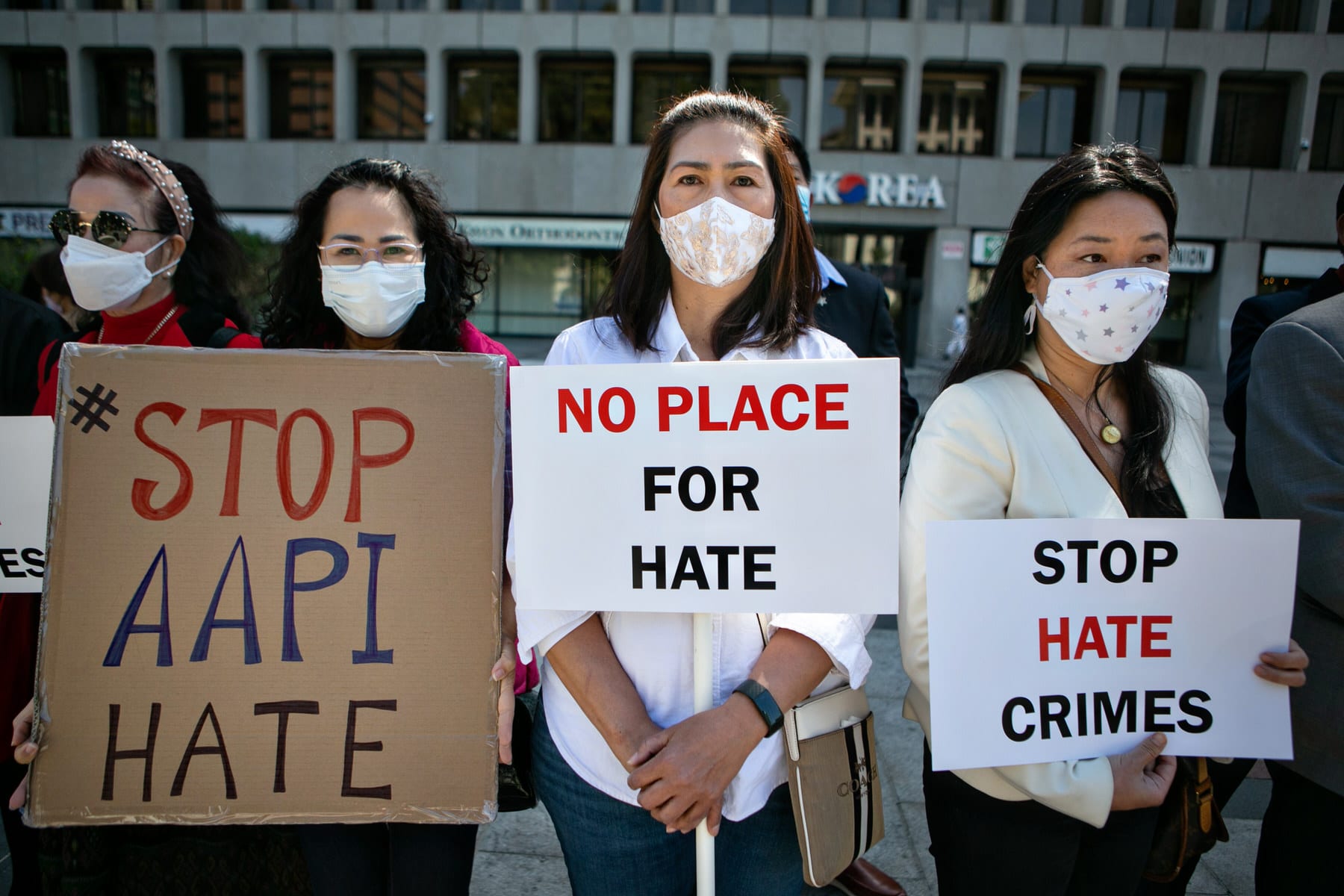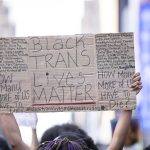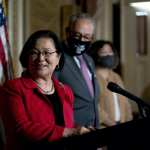On March 16, eight people were killed when a White gunman opened fire in three Atlanta area spas. All but one of the victims were women, and six were of Asian descent. The attacks sparked an outpouring of grief and anger, and drew attention to anti-Asian violence that many activists and community leaders attribute to former President Donald Trump’s xenophobic rhetoric during the pandemic.
On May 11, a grand jury indicted the 22-year-old gunman in four of the killings. Fani Willis, the Fulton County district attorney, is seeking hate crime charges and capital punishment.
According to a study by the Center for the Study of Hate and Extremism, hate crimes against Asian Americans and Pacific Islanders increased 150 percent in 2020. Since March 2020, nearly 3,800 incidents have been reported to Stop AAPI Hate, a coalition of community organizations — with 68 percent reported by women. According to a Pew Research report published in July 2020, more than 30 percent of Asian adults said they had been subject to racial slurs or jokes since the coronavirus outbreak began last spring.
Days after the violence in Atlanta, President Joe Biden urged Congress to pass the COVID-19 Hate Crimes Act. Introduced by Sen. Mazie Hirono of Hawaii and Rep. Grace Meng of New York on March 11, the legislation would address “the surge in violence against AAPI communities,” assign a point person in the Justice Department to review pandemic-related hate crimes and provide support for law enforcement agencies. The bill passed the Senate with bipartisan support and awaits a vote in the U.S. House.
Asian Americans and Pacific Islanders are one of many groups who have been the focus of high-profile domestic attacks that were scrutinized as potential hate crimes, motivated by race or religion. According to the FBI, there are thousands of these incidents each year.
But what do these numbers mean? Most experts agree that U.S. hate crimes are vastly undercounted, and the country’s accounting of these crimes remains deeply flawed.
What is a hate crime?
Hate crimes are crimes that are typically violent and motivated by prejudice.
“The offender doesn’t need to actually hate the victim,” said Dr. Phyllis Gerstenfeld, professor and chair of criminal justice at California State University Stanislaus. “They just need to select them based on a group affiliation — and only certain groups are protected depending on the state.”
The Federal Bureau of Investigation, the lead investigative agency for civil rights violations, defines a hate crime as “a criminal offense against a person or property motivated in whole or in part by an offender’s bias against a race, religion, disability, sexual orientation, ethnicity, gender or gender identity.”
Forty-seven states have hate law designations. Arkansas, South Carolina and Wyoming are currently the only states without.
In August 2020, Arkansas legislators introduced a hate crimes bill that was quickly met with resistance from conservatives and stalled. On Monday, the state’s Senate Judiciary Committee passed a dramatically scaled-back measure that no longer referred to race, sexual orientation or gender identity. Instead, it defined hate crimes as crimes motivated by a person’s “mental, physical, biological, cultural, political or religious beliefs or characteristics.” The bill, which doesn’t explicitly refer to “hate crimes,” is advancing to the full Senate for a vote.
There is no universal definition of what constitutes a hate crime, resulting in different levels of protection across the country. Some experts argue that the working definition of hate crimes is too simplistic and lean too heavily on what the accused person says.
“I think people are looking for a straightforward, black-and-white motive,” said Lu-in Wang, a law professor at the University of Pittsburgh. “So when a perpetrator says they are not motivated by hate, they take their word for it. … People ought to recognize that what often motivates a hate crime is not actual animus towards a group but the fact that that group has been designated by society as an acceptable group to target.”
For example, Wang said, if a perpetrator seeked to rob an Asian-owned business because he knew they’d be more scared to go to the police than other groups, that should be considered a hate crime.
“Those opportunistic crimes based on bias are just as harmful as the ones motivated by actual hatred,” Wang said.
What is the history of hate crimes in America?
Crimes motivated by race-based bias predate legislation and definition. But the term “hate crime” can be traced back to 1985, when Reps. John Conyers, Barbara Kennelly and Mario Biaggi cosponsored a bill — signed into law in 1990 — called the Hate Crime Statistics Act, Wang said.
Obviously crimes motivated by hatred for a certain group were around well before 1985. When prosecuted, civil rights laws were often invoked. But some of America’s laws have upheld disparate treatment and said acts were not crimes if committed against certain groups, according to Matthew Charity, professor of law at Western New England University.
The 1850 Fugitive Slave Act and the Supreme Court decision in Dred Scott v. Sandford reinforced the notion that crimes against people of African descent were not subject to the same level of protection as White people.
But then, with the 1871 Ku Klux Klan Act, the government made an attempt to enforce protections against domestic terrorism on the basis of race. The Justice Department was also formed around then, Charity said, and this period saw an increased effort to protect the civil rights of Black people.
The late 19th and early 20th century saw a reversion to discrimination in state constitutions with the rise of eugenics and “scientific arguments” supporting racism and anti-miscegenation laws. The passage of the Civil Rights Act of 1964, prompted in part by the murders of three civil rights workers in Mississippi by the Ku Klux Klan, then led to new protections and attempts to foster civil rights for Black people.
Protections have been added since the first hate crime law. The Matthew Shepard and James Byrd Jr. Hate Crimes Prevention Act of 2009 is the first federal statute to allow federal criminal prosecution of hate crimes motivated by bias against sexual orientation or gender identity.
Bridgette Baldwin, a law professor at Western New England University, said it’s important to remember that hate crimes have “been going on forever,” but now they are more visible with the advent of phones and social media. There’s still no way for us to know what the exact toll is.
Who decides whether a crime should be designated as a hate crime?
Technically, at both the state and federal level, a law enforcement official decides whether to record if a crime is a hate crime, but it’s a multi-step process with many factors, said Gerstenfeld, the author of a textbook about the causes, controls and controversies surrounding hate crimes.
“Think of it as a funnel,” Gerstenfeld said. “Typically, a victim has to characterize the crime as a hate crime to the responding officer. Then the officer has to record the incident as a hate crime, which is then sent to the FBI voluntarily. Then, assuming an arrest is made, a prosecutor has to decide it is a hate crime — which they rarely do. And then the ultimate decision maker is usually the jury, who has to decide without a doubt that there was a motive.”
The key is that you have to prove motive, Gerstenfeld said. The jury is tasked with getting inside the mind of the offender, but a firsthand confession is not the only way to do that.
Baldwin said the jury is told to account for both direct and circumstantial evidence.
“For example, if you come into a room and see my husband on the ground, and I have a bloody knife in my hand, the circumstantial evidence would point to me stabbing him,” Baldwin said. In addition to the facts of the incident, prosecutors will also comb through an offender’s background to see what groups they are a part of, the content of their social media accounts and see what connected them to the situation.
How are these crimes counted and what is missed?
It is widely acknowledged that the number of hate crimes is well above what is reported by the FBI because not all jurisdictions track them; some don’t share that data with the federal agency; and the small percentage of hate crime charges that make it to court rarely end in conviction.
The FBI reported more than 7,300 hate crimes in 2019, the most recent data available. More than half of these crimes targeted a victim based on a race, ethnicity or ancestry bias; about 20 percent because of a religious bias; and about 15 percent because of a sexual orientation bias. About two-thirds of the offenses were against people and about a third against property.
Nearly 3,000 agencies don’t send the federal agency any data about bias-motivated crime at all. And of the 15,588 law enforcement agencies that do, only 14 percent reported any hate crimes in their jurisdictions in 2019.
Estimates from the Bureau of Justice Statistics show there could be up to 250,000 hate crimes each year, based on a survey asking people if they’ve ever been victims of a hate crime.
The total count drops at every stage of the process from incident to the court proceedings.
“There are many crimes that are just counted as regular assault or murder, even if it met the definition of a hate crime,” Baldwin said. “The authorities have to recognize that a hate crime exists and actually report it if it is to be counted.”
State agencies are not required to track bias-motivated incidents, and the ones that do can interpret hate crimes differently on a department level and an individual level.
“We don’t really have a good sense from the numbers,” Gerstenfeld said.
Not formally acknowledging hate crimes for what they are is a disservice to the victims and a missed opportunity for leaders to “send a message to everyone that this isn’t a behavior that our society stands for,” Gerstenfeld said. Without that acknowledgement, victim groups can feel isolated and ignored.
How are hate crime data and statistics used?
Experts agreed that the numbers — though incomplete — can still be used to look at trends. Whether there has been an uptick or decrease in reported hate crimes and patterns around who the offenders and victims are can inform the actions of police departments, policymakers and community leaders.
Many states respond to hate crimes by enhancing the existing penalty of an offender. The justification for this is twofold, according to Wang.
“One, the crime itself is more harmful because of the biased motive,” Wang said. “And two, the perpetrator is viewed as more culpable, did a worse thing and should be punished more. … It’s controversial because some people think an enhanced punishment is unnecessary because everyone is equal and all crimes are bad.”
But Wang argued that the existence of hate crime statutes are important for vulnerable groups, who are often the victims of these crimes. It is the state’s way of denouncing the bias and standing behind the targeted group, she said.
How can the U.S. improve the way we track hate crimes?
Gerstenfeld argued that police officers and prosecutors need more training so they could get a better idea of how to identify bias-motivated actions and how to handle the situation. She also said communities in law enforcement needed to improve their relationships with marginalized communities who might be uncomfortable reporting these incidents.
Baldwin proposed that all states should be required to report hate crimes to the FBI. Another improvement could be putting more onus on the legal system to prove bias was not involved instead of putting the onus on the victim to prove that bias was involved. Charge more crimes as hate crimes and let the jury figure it out, Baldwin said.
“Until we’re willing to … acknowledge acts of hate, there’s not going to be better tracking,” Baldwin said. “We’re not willing to accept the systemic nature of the bad things that we do. We aren’t willing to accept that racism, sexism and all the isms are alive and condoned. And until we recognize that, I think it’s going to be a slow, slow process.”






